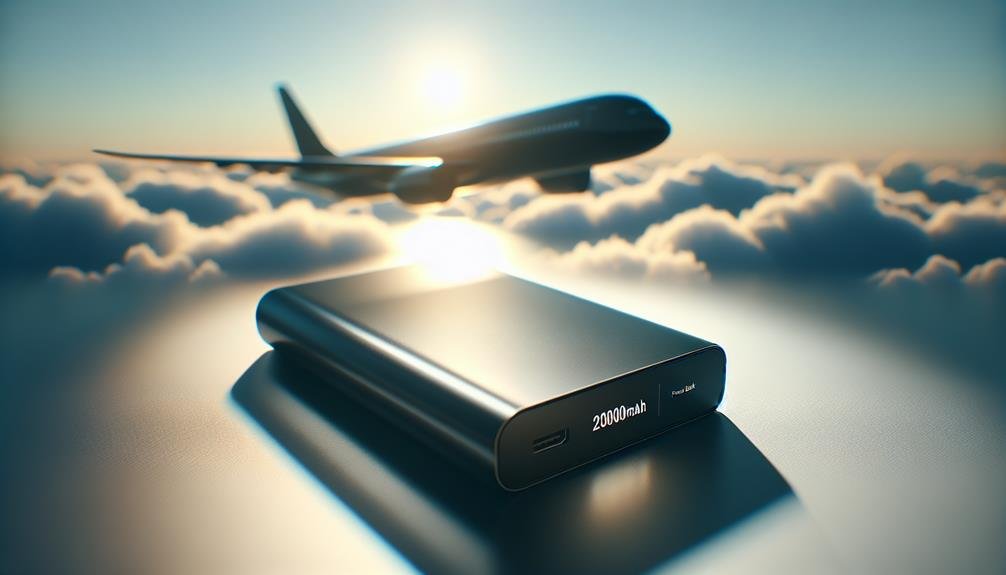Yes, you can bring a 20,000mAh power bank on a plane, but make sure it's within the airline's regulations. Most airlines allow power banks up to 100Wh (about 27,000mAh) without special approval. Your power bank must be stored in your carry-on baggage, not in checked luggage, due to the fire risk associated with lithium-ion batteries. Always check your power bank's Wh rating and have it easily accessible for security checks. Some airlines may have specific requirements or need prior approval for power banks exceeding 100Wh. Stay informed on these details for a smooth journey. Learn more about safe packing and alternatives.
Airline Regulations Overview
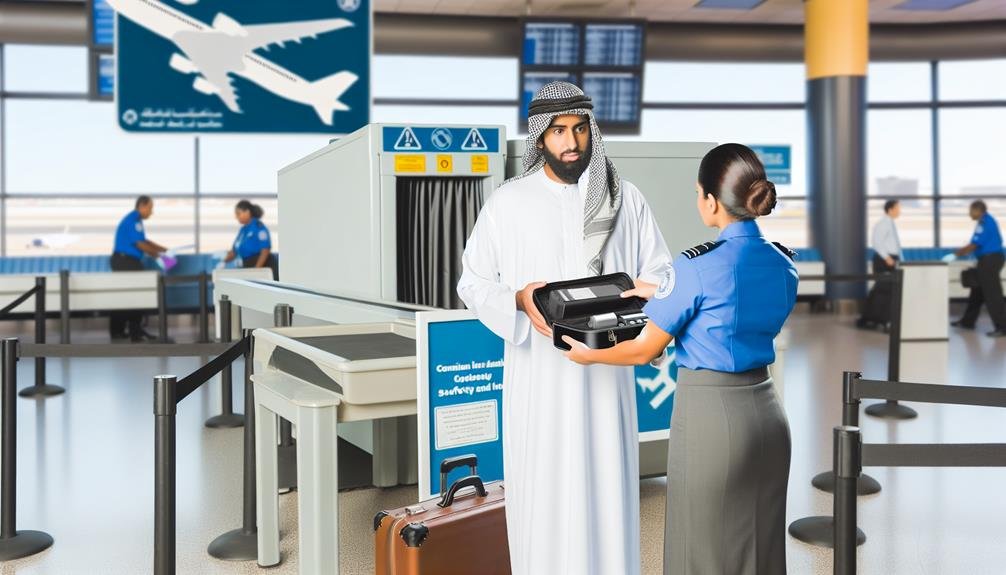
When you're planning to bring a 20000mAh power bank on a plane, it's important to understand the airline regulations that govern the transport of lithium-ion batteries. Airlines have specific restrictions to guarantee passenger safety, and these rules often revolve around battery capacity and power bank safety.
Most airlines allow power banks with a battery capacity of up to 100Wh (Watt-hours) without requiring special approval. Since your 20000mAh power bank typically falls within this range, it should be acceptable. However, you should always verify the exact Wh rating of your device as it can vary. Some airlines might have more strict restrictions, so it's crucial to check the travel regulations of the airline you're flying with.
Power banks must be carried in your carry-on luggage, not in checked baggage. This is because lithium-ion batteries pose a fire risk, and cabin crew need to be able to address any potential hazards immediately. For added safety, make sure your power bank has safety certifications, such as UL or CE markings.
Understanding Power Bank Capacity
To guarantee your power bank complies with airline regulations, you need to understand its capacity, typically measured in milliampere-hours (mAh). Converting this to watt-hours (Wh) is essential, as airlines often use this metric to assess safety compliance. By knowing your power bank's Wh, you can avoid potential risks and guarantee adherence to airline guidelines.
Measuring Battery Capacity
Understanding the capacity of your power bank, measured in milliampere-hours (mAh), is important for guaranteeing compliance with airline regulations and evaluating its suitability for your travel needs. The mAh rating tells you how much charge the power bank can store, which directly impacts how many times it can recharge your devices and its overall battery life. For instance, a 20000mAh power bank can charge a standard smartphone multiple times, making it ideal for long trips.
When preparing to fly, you need to be aware of airline policies regarding power banks. Most airlines allow power banks up to 100Wh in carry-on luggage, translating to about 27000mAh for standard lithium-ion batteries. However, regulations can vary, and exceeding these limits could result in confiscation or fines.
Assessing risk is essential. A power bank that's too large could be flagged by security, causing delays or even safety concerns. Always check the airline's guidelines before you pack. Additionally, understanding the capacity helps you gauge how well the power bank will meet your charging needs during travel. By doing so, you ensure both compliance and peace of mind, keeping your devices charged and your journey smooth.
Watt-Hour Calculation
Determining the watt-hour (Wh) rating of your power bank is crucial for ensuring it adheres to airline regulations and evaluating its suitability for travel. To calculate the watt-hour rating, you'll need to use the formula: Wh = (mAh × V) / 1000. For example, if your 20000mAh power bank operates at a voltage of 3.7V, the watt-hour conversion yields about 74Wh. This calculation is pivotal for understanding power bank safety and confirming your device meets capacity restrictions specified by airlines.
Knowing the watt-hour rating helps you evaluate the risk associated with battery storage during flights. Most airlines allow power banks below 100Wh in carry-on luggage without special permissions, indicating that your 20000mAh power bank likely falls within this limit. However, exceeding this threshold can lead to the power bank being prohibited onboard.
Always double-check the voltage and capacity of your power bank to perform an accurate watt-hour calculation. This not only guarantees compliance with airline regulations but also enhances power bank safety by preventing potential overheating or fire hazards. Properly understanding and applying these calculations will ensure the safety of you and your fellow passengers during air travel.
Airline Regulations Compliance
Verifying your power bank complies with airline regulations involves checking its capacity against the airline's specified limits. Most airlines adhere to guidelines set by aviation authorities. Power banks up to 100 watt-hours (Wh) are generally allowed in carry-on luggage without prior approval. For a 20000mAh power bank, you'll need to calculate the watt-hour rating by multiplying the capacity (20,000mAh) by the voltage (usually 3.7V for lithium-ion batteries), then divide by 1,000. This gives you 74Wh, which is within the acceptable range.
However, it's important to confirm the specific travel restrictions of your airline. Some carriers may have stricter rules or require you to declare power banks exceeding a certain battery size. Failing to comply can result in confiscation or even fines, posing a significant risk to your travel plans.
Additionally, power banks must be carried in your carry-on luggage, as placing them in checked baggage is prohibited due to the fire risk lithium-ion batteries pose. Always check the regulations of not just your departing airline but also your return flight to ensure seamless compliance. Staying informed minimizes risks and enhances your safety during travel.
Lithium-Ion Battery Restrictions

When bringing a 20000mAh power bank on a plane, it's important to be aware of the lithium-ion battery restrictions imposed by aviation authorities. These restrictions focus on battery safety to guarantee a secure travel experience. Lithium-ion batteries, including those in power banks, are classified as hazardous materials due to their potential risk of overheating and causing fires.
To help you navigate these restrictions, here's a quick reference table:
| Regulation Body | Maximum Allowed Capacity |
|---|---|
| FAA (USA) | 100Wh (approx. 27000mAh) |
| EASA (Europe) | 100Wh |
| IATA | 100Wh |
| CAAC (China) | 100Wh |
| CASA (Australia) | 100Wh |
For a 20000mAh power bank, which typically falls around 74Wh, you should be within the limits set by most aviation authorities. However, understanding these values helps ensure your travel essentials don't pose any risk.
Always check with your specific airline, as some may have additional regulations. Keeping your power bank in your carry-on bag allows for easier monitoring during the flight, thereby enhancing overall safety. By adhering to these guidelines, you contribute to a safer travel environment for everyone on board.
Carry-On Vs. Checked Baggage
Given the lithium-ion battery restrictions, it's important to understand whether your 20000mAh power bank should be in your carry-on or checked baggage. Airlines and regulatory bodies impose clear guidelines to guarantee passenger safety, particularly related to potential fire hazards.
- Carry-On Baggage: Most airlines mandate that power banks, especially those with lithium-ion batteries, be carried in your carry-on luggage. This allows the cabin crew to manage any incidents swiftly and effectively. Size restrictions on power banks typically cap at 100Wh (watt-hour); a 20000mAh power bank usually falls below this threshold, but always verify the exact specifications.
- Checked Baggage: Storing power banks in checked baggage is generally prohibited due to the inability to monitor and contain any thermal runaway incidents. The confined space and lack of supervision pose a significant risk, making it a non-viable option under travel restrictions.
- Safety Protocols: Ensuring your power bank is within size restrictions and placed in your carry-on mitigates risks associated with lithium-ion batteries. Proper storage and handling are essential, especially during air travel, where safety protocols are stringent.
Understanding these guidelines will help you travel safely and comply with regulations designed to protect everyone on board.
TSA Guidelines
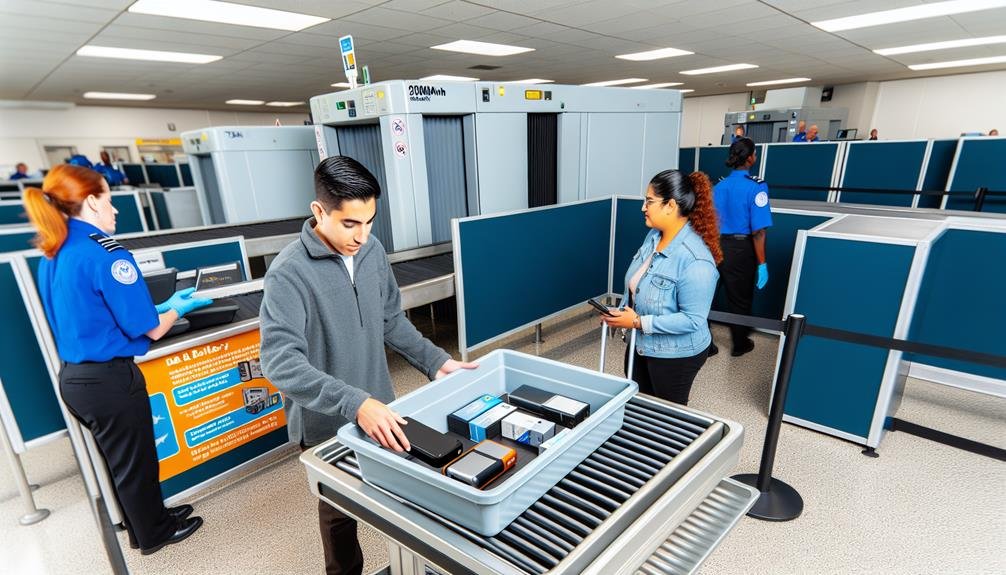
When bringing a 20000MAH power bank on a plane, you must comply with TSA guidelines, specifically the capacity limit rules. Power banks of this capacity are typically allowed only in carry-on baggage, not checked luggage, to mitigate fire risks. Confirm that your power bank meets the watt-hour limitations to avoid confiscation or denial of boarding.
Capacity Limit Rules
The TSA guidelines stipulate that power banks with a capacity exceeding 100 watt-hours (Wh) must receive airline approval before being allowed on board. When you're handling power bank restrictions, especially for international travel, it's important to understand these capacity limits. This guarantees your device complies with safety precautions designed to mitigate risks like overheating or fire hazards.
To help visualize the key points, consider these guidelines:
- Power Bank Capacity: Most power banks list their capacity in milliampere-hours (mAh). To convert this to watt-hours, you can use the formula: (mAh * Voltage) / 1000. For example, a 20000mAh power bank typically operates at 3.7V, equating to 74Wh, which is within the allowable limit.
- Approval Process: If your power bank exceeds 100Wh but is under 160Wh, you must seek airline approval. You can usually do this by contacting the airline's customer service ahead of your flight.
- Multiple Devices: You can carry multiple power banks, but the combined watt-hour limit should not exceed 300Wh. Always check the airline's specific policies as they may vary.
Adhering to these capacity limits and safety precautions will guarantee a smooth and safe travel experience.
Carry-On Vs. Checked
For your safety and compliance with TSA guidelines, power banks must be carried in your carry-on baggage and are prohibited from being placed in checked baggage. This regulation is essential for battery safety, as lithium-ion batteries can pose fire risks if they're damaged or short-circuited during transit. Understanding carry-on restrictions guarantees that you and your fellow passengers remain safe.
The following table summarizes key points for carrying power banks:
| Parameter | Carry-On Baggage |
|---|---|
| Maximum Allowed Capacity | 27,000mAH |
| Power Bank Quantity Limit | Two per passenger |
| Placement | Must be in carry-on |
| Prohibited in Checked Baggage | Yes |
| Airline Notification Required | Sometimes* |
*Check with your airline for specific requirements.
Adhering to TSA guidelines reduces the risk of accidental ignition. Power banks up to 27,000mAH are typically allowed, but they must be in your carry-on to promptly address any issues that arise. If you're carrying multiple power banks, make sure they meet the quantity limit and capacity regulations.
International Flight Considerations
Understanding international regulations for bringing a 20000mAh power bank on a plane requires grasping each airline's specific policies and the International Air Transport Association's guidelines. These rules guarantee both your safety and the safety of others on board. It's crucial to know that power banks are considered lithium-ion batteries, which are subject to strict regulatory controls.
First, you'll need to be aware of the voltage limits. Most 20000mAh power banks are within acceptable voltage ranges, but it's your duty to verify this. Typically, power banks should not exceed 100 watt-hours (Wh). You can calculate watt-hours by multiplying the capacity in ampere-hours (Ah) by the voltage (V).
Next, consider the charging restrictions. Many airlines prohibit charging power banks during the flight to avoid overheating risks. Always check the airline's policy and adhere to these guidelines.
Here are key points to remember:
- Voltage Limits: Guarantee your power bank doesn't exceed the 100Wh limit.
- Charging Restrictions: Avoid charging during the flight unless explicitly allowed.
- IATA Guidelines: Familiarize yourself with the International Air Transport Association's regulations.
Airline-Specific Policies
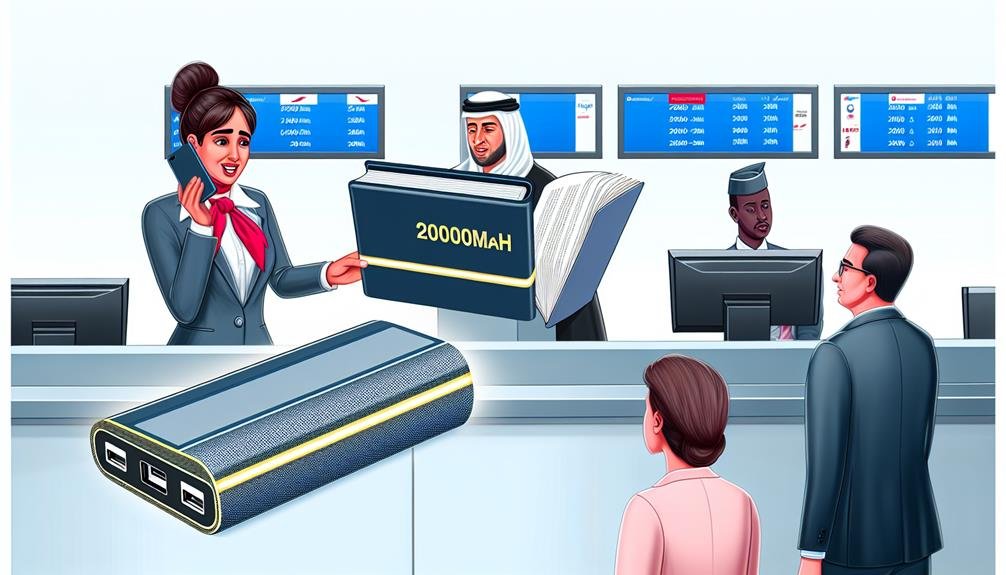
You'll need to refer to your specific airline's policies to make certain your 20000mAh power bank complies with their regulations, as these can vary greatly between carriers. Airlines impose restrictions based on power bank size and lithium-ion battery capacity to mitigate safety risks.
Different airlines may have varying thresholds for the maximum allowable capacity. Generally, power banks up to 100Wh (watt-hours) are acceptable without prior approval, but anything above that may necessitate special permission. To convert your power bank's mAh to Wh, use this formula: (mAh/1000) * Voltage. Most 20000mAh power banks operate at 3.7V, translating to 74Wh, which typically falls within acceptable limits.
| Airline | Maximum Capacity Allowed | Special Permission Required | Carry-On Only | Checked Baggage |
|---|---|---|---|---|
| Delta Airlines | Up to 100Wh | Above 100Wh | Yes | No |
| American Airlines | Up to 100Wh | Above 100Wh | Yes | No |
| Emirates | Up to 100Wh | Above 100Wh | Yes | No |
| British Airways | Up to 100Wh | Above 100Wh | Yes | No |
| Lufthansa | Up to 100Wh | Above 100Wh | Yes | No |
Always verify these details on your specific airline's website to ensure compliance and avoid any disruptions during your journey. Prioritizing safety by adhering to airline restrictions is essential for a smooth travel experience.
Safely Packing Your Power Bank
Properly packing your power bank is crucial to guarantee compliance with airline regulations and to minimize the risk of damage or safety hazards during your flight. When packing your 20000mAh power bank, you need to make sure it's secure and accessible for airport security inspections. Here are three critical steps to follow:
- Use Proper Packaging: Store your power bank in a protective case that shields it from physical damage. The case should be non-metallic and designed to prevent short circuits. This minimizes the risk of accidental activation or damage during transit.
- Carry in Hand Luggage: Always pack your power bank in your hand luggage, not checked baggage. Airlines typically require that lithium-ion batteries be carried in the cabin to allow immediate action in case of a thermal runaway incident.
- Avoid Contact with Metal Objects: Make sure that the power bank doesn't come into contact with keys, coins, or other metallic items. Use a dedicated compartment or a zip-lock bag within your hand luggage to keep the power bank isolated, reducing the risk of short-circuits.
Alternatives to High-Capacity Power Banks
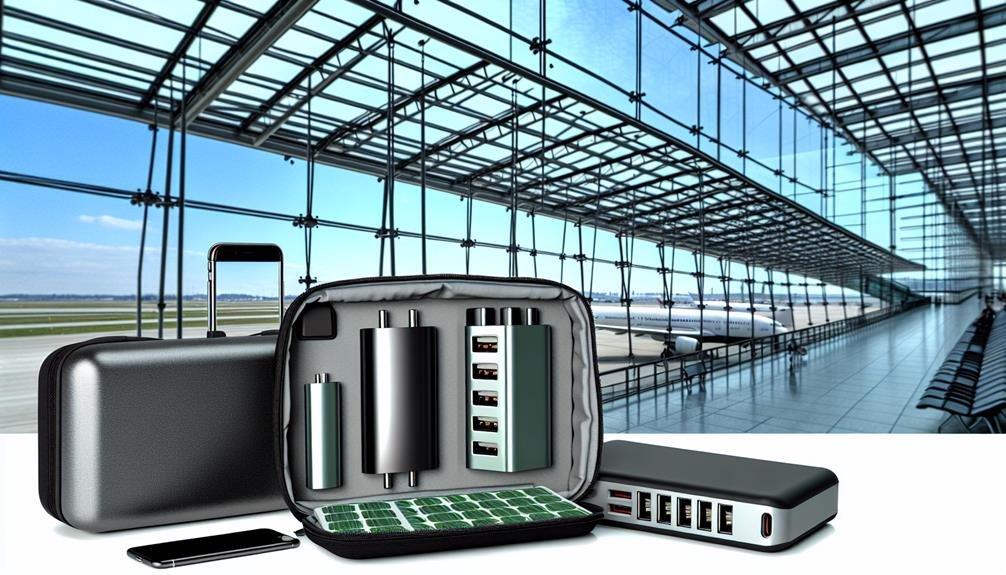
While a 20000mAh power bank offers substantial capacity, there are alternative power solutions that align more easily with airline regulations and reduce the risk of potential hazards. One option is to use lower-capacity portable chargers, which are often less restricted and still provide enough power to get you through a flight. For instance, power banks under 100Wh (approximately 27000mAh) generally face fewer restrictions and can often be carried without special approval.
Another alternative is leveraging solar power chargers. These devices convert sunlight into energy, which can then be used to charge your electronics. Although they might not be as fast or efficient as traditional power banks, they offer a renewable and safe option for travelers.
| Alternative | Benefit |
|---|---|
| Lower-capacity chargers | Fewer restrictions, safer to carry |
| Solar power chargers | Renewable energy, no battery risks |
| Multi-port chargers | Charge multiple devices simultaneously |
| Built-in power solutions | Integrated into luggage, no extra item |
Using these alternatives not only guarantees compliance with airline safety regulations but also minimizes the risks associated with high-capacity batteries. Prioritizing safety and regulatory adherence can make your travel experience smoother and worry-free.
Frequently Asked Questions
What Should I Do if My Power Bank Starts Overheating During the Flight?
If your power bank starts overheating during the flight, follow emergency procedures and troubleshooting steps. Notify the crew immediately, adhere to safety precautions, and follow protocol to guarantee everyone's safety. Don't ignore any risk signs.
Can I Use My Power Bank to Charge Devices While on the Plane?
You can use your power bank to charge devices on the plane, but follow charging etiquette and confirm power bank compatibility with in-flight charging restrictions. Avoid using it during airplane entertainment to prevent overheating risks.
Are There Any Specific Brands of Power Banks Recommended for Air Travel?
Did you know 80% of power bank incidents happen due to poor quality? For air travel, the best brands like Anker and RAVPower prioritize safety precautions, ensuring compliance with airline regulations and minimizing risks during your journey.
How Do I Properly Dispose of a Damaged Power Bank Before Flying?
Before flying, make sure you follow disposal regulations and check recycling options for damaged power banks. Prioritize safety precautions and familiarize yourself with emergency procedures to mitigate risks associated with improper disposal of hazardous materials.
Can I Bring Multiple Smaller Power Banks Instead of One High-Capacity Power Bank?
You can bring multiple smaller power banks as an alternative, adhering to power bank limitations. When traveling with multiple power banks, verify each one meets airline regulations to minimize risks and guarantee safety compliance.

